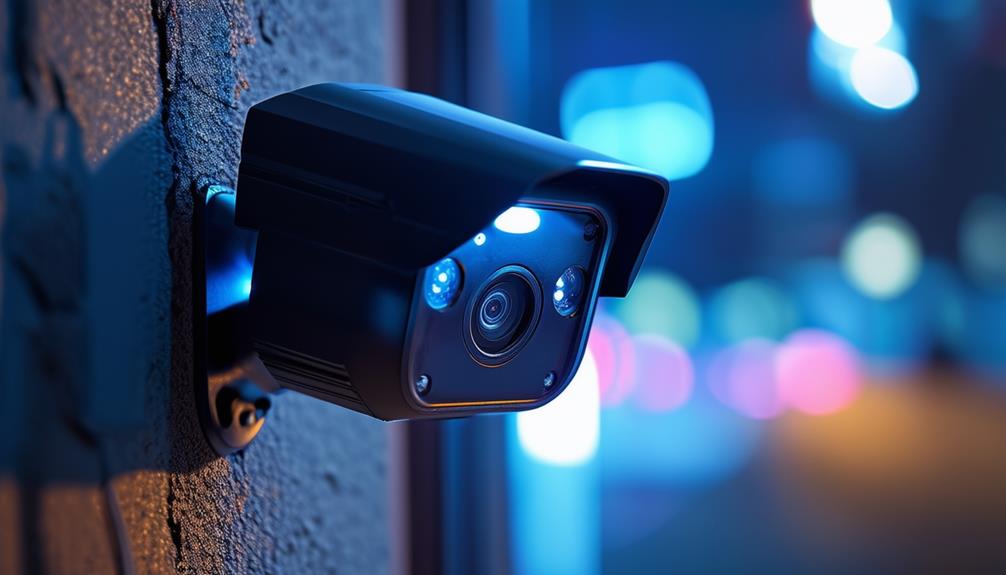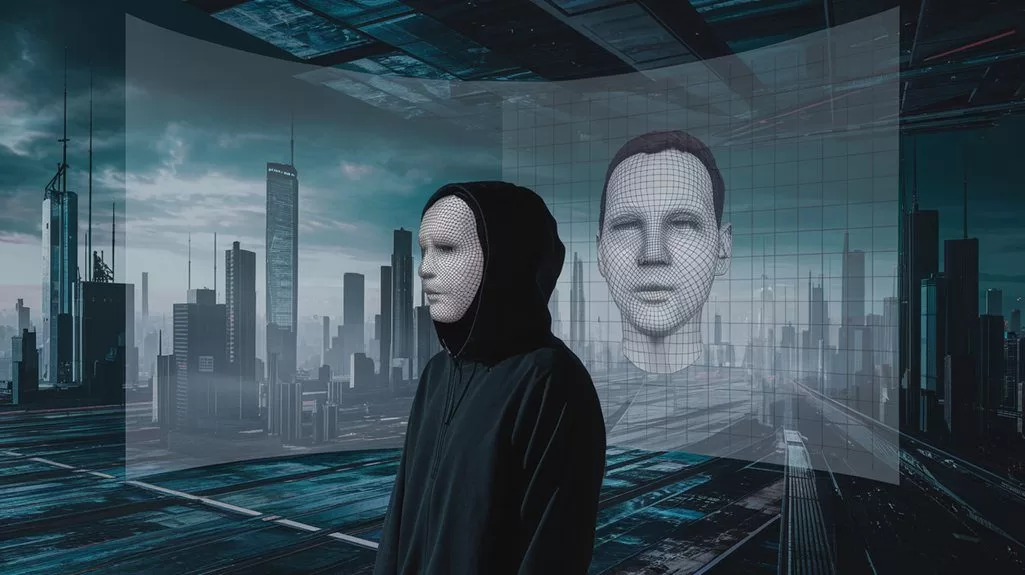Facial recognition technology plays a pivotal role in surveillance by infiltrating public spaces through covert or remote identification on a mass scale without consent. It leverages vast datasets and algorithmic matches to track individuals, often disproportionately affecting marginalized communities. Major tech companies have paused sales due to rights concerns, but governments and some companies are expanding its use. As we explore further, we unravel the complex web of facial recognition in surveillance, from biased algorithms to enhanced security measures.
Key Takeaways
- The use of facial recognition technology in surveillance raises privacy concerns due to the potential for mass profiling without consent.
- In law enforcement contexts, facial recognition is used to identify individuals, contributing to mass surveillance and possible privacy violations.
- Facial recognition technology relies on biometric identifiers such as face prints to verify identities and can be deployed in public spaces.
- Regulation and oversight are needed to address bias and protect privacy rights in the deployment of facial recognition technology.
- Inclusion in databases and the use of the technology without explicit consent pose significant risks to privacy and civil liberties.
Surveillance in Public Spaces
The widespread use of facial recognition technology in public spaces, which allows for mass, covert identification without consent, is now routine for both federal and local law enforcement agencies. This technology, powered by companies like Clearview AI, has dramatically expanded the capabilities of surveillance systems. By leveraging billions of images from various sources, including social media and government databases, facial recognition databases have grown to enable quick, accurate matches. The ease and speed of this technology have made it a staple in law enforcement operations.
However, concerns abound regarding both privacy implications and accuracy. Facial recognition often operates without explicit consent, and its use can have disproportionate effects on specific demographics. For instance, studies have noted higher false positive rates among women and individuals with darker complexions.
These issues have sparked intense debate and a wave of regulations aimed at curtailing the technology’s use. As federal agencies like the FBI and local police departments continue to incorporate facial recognition, it’s essential to carefully weigh these considerations to guarantee the technology serves the public interest rather than infringes upon it.
Facial Recognition Applications
Facial recognition technology has expanded into numerous commercial and public sectors beyond law enforcement, with applications ranging from securing personal devices to identification at airport check-ins, underscoring the widespread reach and complexity of this powerful biometric tool.
- *Retailers use facial recognition to discourage shoplifting and improve customer experiences.*
- *Private airlines utilize the technology for airport security and passenger identification.*
- *Security teams at large venues, like sports arenas and concert halls, employ it for crowd monitoring.*
- *Individuals safeguard their personal devices with facial recognition technology.*
- *Government entities, such as passport control and national ID systems, depend on facial recognition for efficient processing and verification.*
These diverse applications raise significant privacy concerns regarding the unchecked collection and use of biometric data. As surveillance technology advances, there’s an increasing need for regulatory frameworks to guarantee transparency and public awareness.
Law enforcement agencies use facial recognition systems extensively, often sharing data with private entities. This interconnectedness demands greater accountability and oversight to prevent misuse. The pervasive presence of facial recognition technology necessitates a sustained effort to balance its benefits with individual privacy and societal concerns.
Enhancing Security Measures

My reliance on face recognition technology has led me to thoroughly understand its crucial role in enhancing security measures.
The implementation of facial recognition in surveillance systems provides faster and more accurate identity verification, enhancing the overall security posture.
This technology facilitates real-time alerts, which not only reduce labor costs but also enhance efficiency in monitoring processes.
Biometric Identifiers Explained
As I explore the world of surveillance, I find myself increasingly concerned about the role of biometric identifiers in our lives. In the context of modern surveillance, biometric identifiers like face prints, fingerprints, and palm prints are used to verify and identify individuals through their unique physical characteristics.
- The Shape of Our Eyes: Iris features can distinguish one person from another.
- Every Step We Take: Gait recognition captures our walking patterns.
- The Sound of Our Voice: Voice prints can identify us through our speech.
- Our Fingerprint Landscape: Fingerprints are unique to each person.
- Unraveling DNA Secrets: DNA holds genetic information that defines us.
These biometric identifiers, however, lead to facial recognition technology that enables covert identification on a mass scale without consent. Mass surveillance, such as facial recognition, poses significant privacy risks that demand our attention.
EPIC advocates for banning face surveillance to protect against the risks associated with these technologies. We must be aware of how surveillance technologies are changing our lives and take steps to guarantee they don’t compromise our privacy and autonomy.
Algorithm Concerns and Bias

Recent studies have disconcertingly revealed that the very algorithms upon which facial recognition technology rests can harbor and perpetuate biases, exacerbating the systemic racism and targeted profiling already embedded within our society. These biases manifest in facial recognition technology through discriminatory error rates, with notably higher misidentification rates for communities of color.
For instance, a study showed that error rates for dark-skinned women were 34.7%, while light-skinned men had a mere 0.8% error rate. This bias is deeply problematic, as it can automate and legitimize harmful societal discrimination.
Furthermore, the use of facial recognition in surveillance raises ethical questions about the potential discriminatory effects of algorithmic biases. It’s vital to address these issues by ensuring that algorithms are developed with fairness and accuracy in mind. NIST’s assessments have shown that even the best algorithms can have a rank one miss rate of 20% in real-world settings, highlighting the need for rigorous testing and regulation.
Concerns about algorithm bias must be addressed to prevent facial recognition technology from becoming a tool that amplifies and legitimates existing societal discrimination.
EPIC Advocacy for Ban
EPIC vigorously advocates for a total ban on facial recognition technology in surveillance to mitigate its egregious threat to privacy. This technology has the capability to secretly and remotely identify individuals on a large scale, a power that poses significant dangers to democratic freedoms and fairness.
- Covert Mass Surveillance: EPIC opposes the unbridled deployment of face surveillance systems in public spaces, as they can monitor movements and link individuals to vast amounts of data without consent.
- Biometric Surveillance Proliferation: We actively comment on federal agency proposals to expand biometric surveillance, advocating for safeguards against abuse.
- Uncovering Hidden Programs: EPIC seeks to uncover any concealed facial recognition surveillance programs and ensure that privacy violations are rectified.
- Legal Oversight: We work diligently to guarantee thorough legal oversight of all facial recognition usage, including the government’s and private sector’s implementation of such technologies.
- Privacy Protection: Ultimately, our goal is to safeguard the privacy and dignity of individuals by firmly opposing unrestricted facial recognition in surveillance.
Illinois Biometric Privacy Law

By enacting the Biometric Information Privacy Act (BIPA), Illinois became the first state to strictly govern the collection, use, and storage of biometric data, setting a standout precedent for regulatory efforts. This landmark legislation explicitly mandates that companies obtain individuals’ consent before collecting biometric data, including facial recognition information. Moreover, it requires businesses to establish retention schedules and guidelines for permanently destroying biometric data to guarantee privacy.
BIPA Key Provisions
| Provision | Details{})
| ————————- | ——————————————————— |
|---|---|
| Consent | Must be explicit and in writing prior to data collection. |
| Retention Schedule | Mandates guidelines for destroying biometric data. |
| Fines | Penalties up to $1,000 for negligent violation and $5,000 for intentional or reckless violation. |
| Scope | Covers biometric identifiers like fingerprints and facial recognition scans. |
| Power to Sue | Provides individuals with a private right of legal action for violations. |
BIPA serves as a pivotal legal framework, ensuring that organizations handle biometric data responsibly and transparently. Its strict requirements for consent and data management profoundly impact companies operating in Illinois, particularly those utilizing facial recognition technology. Failure to comply with BIPA can result in substantial fines, making it essential for businesses to understand and adhere to these regulations.
Facial Recognition Limitations
Despite its promising potential, facial recognition technology faces significant limitations in accuracy, reliability, and fairness, which must be addressed to guarantee the preservation of individual privacy and civil rights.
Facial Recognition Limitations:
- Racial Bias: Studies consistently show that facial recognition algorithms exhibit racial bias, leading to misidentifications that disproportionately affect people of color, particularly dark-skinned individuals.
- Higher Error Rates: Facial recognition systems are less accurate when identifying individuals from marginalized communities, heightening the risk of wrongful arrests and civil rights violations.
- Differentiation Challenges: Facial recognition systems struggle to differentiate between similar faces, increasing the likelihood of false positives or false negatives.
- Lack of Oversight: Inadequate regulation and accountability in the use of facial recognition technology lead to significant risks for individuals and society.
- Threat to Civil Rights: The inaccuracies of facial recognition highlight the urgent need for stricter regulations and oversight to secure that civil rights are protected and privacy rights are maintained.
These limitations highlight the critical need for a more thoughtful and regulated approach to facial recognition technology to prevent further harm and secure that it doesn’t perpetuate discrimination.
Impact on Civil Liberties

In the context of facial recognition in surveillance, I find it essential to focus on the possible impact on our civil liberties.
The use of facial recognition technology by governments and private companies raises significant concerns about the erosion of privacy and the potential for mass profiling without individual consent.
I believe this technology poses a direct threat to our right to privacy and the freedom to move unmonitored in public spaces.
Surveillance Concerns Raised
As I explore the world of facial recognition in surveillance, the potential for mass, covert identification without consent raises significant concerns about the erosion of civil liberties and privacy rights. This technology can be used to track individuals, building detailed profiles of their movements and activities without their knowledge or consent. Such blanket surveillance goes against the principles of democracy and can lead to a society where individuals are constantly monitored and controlled.
- Detecting faces in crowded spaces, shaping taxpayer-founded surveillance offices to monitor marginalized voices
- Digging through social media, matching each selfie to a name, building evergrowing databases
- Scanning every visitor at stadiums and shopping malls, secretly analyzing every face that passes a camera
- Creating ‘watchlists’ of ‘high-risk individuals’ in a never-ending nightmare of suspicion
- Chasing shadows, using AI to predict and criminalize the actions of the accused, pre-emptively
Privacy in Public Spaces
The use of facial recognition technology in public spaces raises significant concerns about the erosion of my privacy and civil liberties, exposing me to potential abuses of power and challenges to personal freedoms.
This technology, when deployed broadly in public areas, can contribute to an environment where I feel constantly monitored, diminishing my sense of anonymity and autonomy. The pervasive surveillance enabled by facial recognition raises disturbing questions about who controls the data amassed and how it might be misused.
Moreover, it can disproportionately impact marginalized communities, creating an atmosphere of oppression and fueling social unrest.
Navigating public spaces shouldn’t involve surrendering my individual privacy rights. I should be able to move freely without the constant scrutiny of facial recognition surveillance.
It’s imperative that governments and private entities are held accountable for the deployment of such technologies, ensuring they conform to strict regulations that safeguard civil liberties and prevent the abuse of power. By embracing robust oversight and transparency, we can maintain some semblance of control over our digital lives and prevent the creep of intrusive surveillance into every aspect of our existence.
Frequently Asked Questions
What Is the Role of Facial Recognition System in Surveillance Systems?
As I examine facial recognition systems in surveillance, I find privacy concerns, accuracy rates, ethical implications, biometric data, and law enforcement use all intertwined. Surveillance cameras, flawed data protection, and facial analysis raise questions about public safety and accountability.
How Does Facial Recognition Help With Security?
I rely on facial recognition to enhance security by accurately identifying suspects, preventing crimes, and increasing efficiency. It reduces human error, tracks movements, and deters criminal activity, ensuring a safer environment.
What Is the Difference Between Facial Recognition and Face Surveillance?
I regard facial recognition technology, which accurately matches images, as distinct from face surveillance, which involves mass tracking and monitoring without consent, raising privacy concerns and ethical implications.
How Does Facial Recognition Help Find Criminals?
I utilize facial recognition technology to improve criminal identification by analyzing surveillance footage and matching biometric data in real-time against existing databases. This accelerates law enforcement’s ability to enhance public safety.









